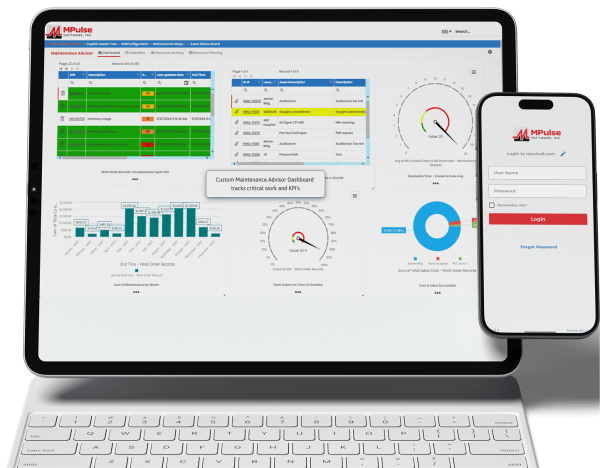MPulse Software strongly believes in supporting the local community and promoting the Willamette Valley as a hi-tech hot spot. So, the chance to partner with Oregon State University (Oregon State) proved to be the perfect opportunity to combine these goals by giving students the opportunity to work in a real-world environment—and solve the type of problems they’re likely to find in a professional workplace.
“We wanted to help young engineering students get started in the world and provide them with some experience. So, I reached out to Oregon State to find out how MPulse can get involved and be a good neighbor,” explained Peter Riley Osborne, Lead Architect/ Developer at MPulse Software, Inc., a maintenance management software developer based in Eugene, Ore.
During their senior year, Oregon State students from the School of Electrical Engineering and Computer Science begin applying skills learn in the classroom to real-world problems. Called Capstone Senior Design Projects, this Oregon State career preparation experience exposes students to the challenges of engineering design and project management in the workplace.
Peter saw the Capstone projects as an opportunity for MPulse to develop relationships with the local community, while also exploring creative ways to engage students in engineering design.
“MPulse has a huge piece of software with a lot of intricacies, but we need creative ways to explore new possibilities,” Peter explained. “The ability to work with a bunch of pretty amazing students on a Capstone project was a perfect fit.”
Table of Contents
Location-Based Engineering
MPulse provides reliable planning, scheduling, tracking, and reporting tools for thousands of equipment and facilities maintenance teams in over 100 industries. Peter’s idea was to engage Oregon State students’ creative thinking to create a prototype of a potential new MPulse feature based on the location of the end user.
“We wanted to develop a way to alert maintenance professionals there might be other work nearby that they could do while they’re close to a location,” Peter explained. “So, if I’m working on an air conditioner on the first floor, I might get an alert on my MPulse app about another task on a floor in the same building or nearby. It would enable MPulse users to improve their efficiency, while also saving time.”
Peter tasked a group of three Oregon State students—Hunter Christiansen, Spencer Schibig, and Branden Holloway—with researching how to design this feature. The students began by researching the right software tools to use, as well as problem solving issues as they cropped up.
“We were working with the Google Flutter software development kit for app design. Hunter, Branden and Spencer did a great job of coming up with different ideas and directions for how this project could go. Through their research, we found a lot of ways to not only apply it to our original idea, but also future-facing possibilities,” Peter said.
Problem Solving Skills
The three students researched different aspects of the project, and then collaborated to find the best solutions. Hunter took on the task of working with geolocation tools; Spencer focused on notifications; and Branden tackled ways to integrate these new tools with MPulse’s Microsoft SQL Server-based application.
“The first hurdle was becoming familiar with MPulse’s database structure, which was a little overwhelming to start with,” Branden explained. “Based on Spencer’s research, we decided Google Cloud Firestore serverless document database would work the best to replicate it for our project. But we had a few hurdles, including the addition and naming of fields. For example, latitude-longitude data for geofencing wasn’t already included in MPulse. So, we needed to figure out the fields they could eventually add to their MPulse application, as well as how to connect everything.”
Problem solving was a key part of the process for the students. Spencer tackled another challenge when app notifications ended up causing battery life issues on devices.
“I used a service called Firebase Cloud Messaging, which allowed each device to subscribe to topics with a unique name,” Spencer said. “But we found battery life was an issue, and we don’t want someone’s phone to die too fast while they’re in the field. So, we found software libraries that used the phone’s native utilities to fix the problem.”
Another challenge was finding the best way to accurately determine the location of the user.
“GPS isn’t super accurate. We found that if you have an address, we could get the coordinates on something like Google Maps API. Then you can translate that into latitude and longitude,” Hunter said. “But there’s a lot of different ways of doing that. We also could use an IP address or even a WiFi connection.”
In addition to software development, the Oregon State students also got firsthand experience with project management and communication skills that will come in handy after graduation. Because of the COVID-19 pandemic, the whole project has been done online—with Peter and the students doing their work together and meeting via Zoom.
“It was the perfect training for working as a team,” Branden said. “You’re not necessarily in the same room as someone, but you’re still able to coordinate. That’s going to be very similar to the way we’ll be working in the real world.”
A Working Prototype
As the project moves towards the finish line, the Oregon State students will present their work before they graduate in Spring 2021. It’s the culmination of the partnership between MPulse and Oregon State that’s developed this year.
“Weekly engagement with industry partners is keystone to the success of our program,” explained explains Dr. Kirsten Winters, Oregon State School of Electrical Engineering and Computer Science Instructor. “Peter is not only providing mentoring to his individual Capstone team, but he also contributes to our class often as a presenter on general tech and career topics. We’re grateful for his dedication to mentoring.”
MPulse, meanwhile, will have a working prototype of a feature set that the company may eventually want to build. But the Oregon State students’ work has gone farther than Peter originally planned.
“We started out just wanting to explore GPS geo-fencing as a possible feature,” Peter said. “But now we’ll have something that actually works. Plus, it will have a lot of fall-down capabilities. For example, if a user doesn’t have a GPS signal or they aren’t getting an accurate GPS signal, they could use WiFi. And we’re still thinking about additional information we might want to use. Like perhaps including frequency information—like how often someone is in a specific place or last visited that location.”
Other unexpected benefits for Peter including hearing the student’s reactions to the MPulse application, which was completely new software to all of them.
“They had some eye-opening comments that may be opportunities to improve our user interface,” Peter said. “Since they aren’t maintenance professionals, they view it in a different way. And that was kind of cool. Because I can get a lot of anecdotal information from our users, but I don’t have engineers looking at our software from that point of view. It gave me a lot of really good information.”
For both MPulse and the Oregon State students, this Capstone project is just the beginning.
“While the code may not directly end up in MPulse, the structure of what we do will be based on what the students have done,” Peter said. “And other projects might be extensions that came out of the research Spencer, Hunter, and Branden did this year. And maybe that’s our next project with Oregon State. Maybe the next group of students will build off their work to advance those ideas.”






